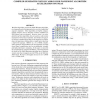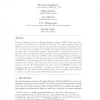150 search results - page 10 / 30 » Parallel Generation of Pseudo-Random Sequences |
HICSS
1995
IEEE
14 years 1 months ago
1995
IEEE
Abstract. We reexamine the limits of parallelism available in programs, using runtime reconstruction of program data-flow graphs. While limits of parallelism have been examined in...
FPL
2008
Springer
13 years 11 months ago
2008
Springer
Wavefront algorithms, such as the Smith-Waterman algorithm, are commonly used in bioinformatics for exact local and global sequence alignment. These algorithms are highly computat...
SC
2003
ACM
14 years 3 months ago
2003
ACM
This paper presents a novel, parallel algorithm for generating top alignments. Top alignments are used for finding internal repeats in biological sequences like proteins and gene...
CEC
2008
IEEE
14 years 4 months ago
2008
IEEE
— Pseudo-random number generators (PRNG) have been intensively used in many stochastic algorithms in artificial intelligence, computer graphics and other scientific computing. ...
CONCUR
2007
Springer
14 years 4 months ago
2007
Springer
Scenario languages based on Message Sequence Charts (MSCs) have been widely studied in the last decade [21,20,3,15,12,19,14]. The high expressive power of MSCs renders many basic ...


